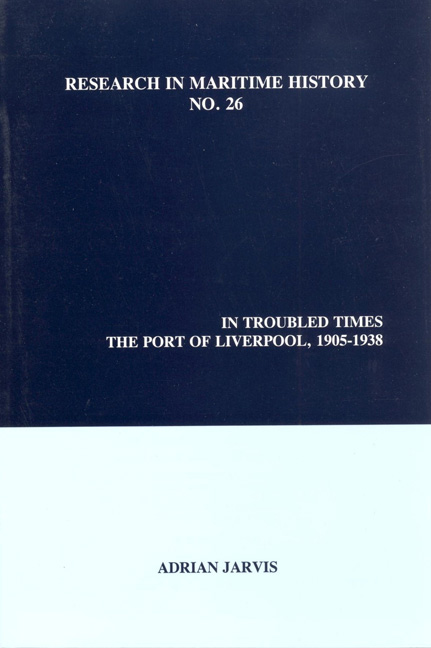Book contents
- Frontmatter
- Table of Contents
- List of Figures
- Foreword and Acknowledgements
- Conversion Factors for Imperial Measurements
- Introduction: The Port of Liverpool in 1905
- Chapter 1 The Port and Its Trade in 1905
- Chapter 2 Gladstone Dock
- Chapter 3 Not Before Time: The Board Keeps its Promise
- Chapter 4 Engineering, Management and Decision-making
- Chapter 5 Making the Customers Happy
- Chapter 6 Sand, Silt and Sewage: The Work of the Board's Dredgers
- Chapter 7 The Provision of Specialist Cargo Facilities
- Chapter 8 Into the Modern World?
- Conclusion: On the Eve of War
- Appendix: Port Efficiency: A Short Methodological Discourse
- A Note on Sources: Abbreviations
- Bibliography
- Index
Chapter 5 - Making the Customers Happy
- Frontmatter
- Table of Contents
- List of Figures
- Foreword and Acknowledgements
- Conversion Factors for Imperial Measurements
- Introduction: The Port of Liverpool in 1905
- Chapter 1 The Port and Its Trade in 1905
- Chapter 2 Gladstone Dock
- Chapter 3 Not Before Time: The Board Keeps its Promise
- Chapter 4 Engineering, Management and Decision-making
- Chapter 5 Making the Customers Happy
- Chapter 6 Sand, Silt and Sewage: The Work of the Board's Dredgers
- Chapter 7 The Provision of Specialist Cargo Facilities
- Chapter 8 Into the Modern World?
- Conclusion: On the Eve of War
- Appendix: Port Efficiency: A Short Methodological Discourse
- A Note on Sources: Abbreviations
- Bibliography
- Index
Summary
The nearest the Mersey Docks Harbour Board had to a “Mission Statement” was the requirement in the Mersey Docks and Harbour Board Act 1857, which established it, that it be a non-profit trust governed by Board members elected by the users of the port to work in the interests of the users. While the Board was more successful in some of its endeavours than others, being popular with the customers was among its weakest suits. It was perceived, often unjustly, as a body dedicated to its own interests, unreceptive to the suggestions or complaints of others and given to “stashing” funds which, in the customers’ view, should be applied to the reduction of dues. This perception was partly a cause and partly an effect of quite unreasonable expectations on the part of the users.
The biggest arguments continued to relate to depth of water, as they had from the 1860s onwards. Depth, it must be stressed again, governed not only the maximum size of ship which could use a particular dock or entrance but also how much freedom to come and go at a variety of states of the tide an entrance could provide for smaller vessels. Depth of water was the most expensive attribute of any dock, and it was a usual engineering yardstick that excavation and construction costs varied roughly as the cube of the depth. It will be clear from earlier chapters that depth was still very much a live issue in the period covered by this book, as three of the four major construction schemes were concerned largely with providing enhanced depth. This issue, and the position of the shipowners, will be considered in due course, but first this chapter will address some of the smaller issues which, taken together, nevertheless had a considerable bearing on the overall effectiveness of the port in shifting goods - and this is perhaps the place to remind the reader of the old truism that docks are not built for ships, they are built for goods.
During the Great War, Liverpool's docks became a national problem when crucial war supplies were delayed by acute congestion which could leave inward-bound ships waiting many days anchored in the river until a berth became free.
- Type
- Chapter
- Information
- In Troubled TimesThe Port of Liverpool, 1905-1938, pp. 113 - 140Publisher: Liverpool University PressPrint publication year: 2003



